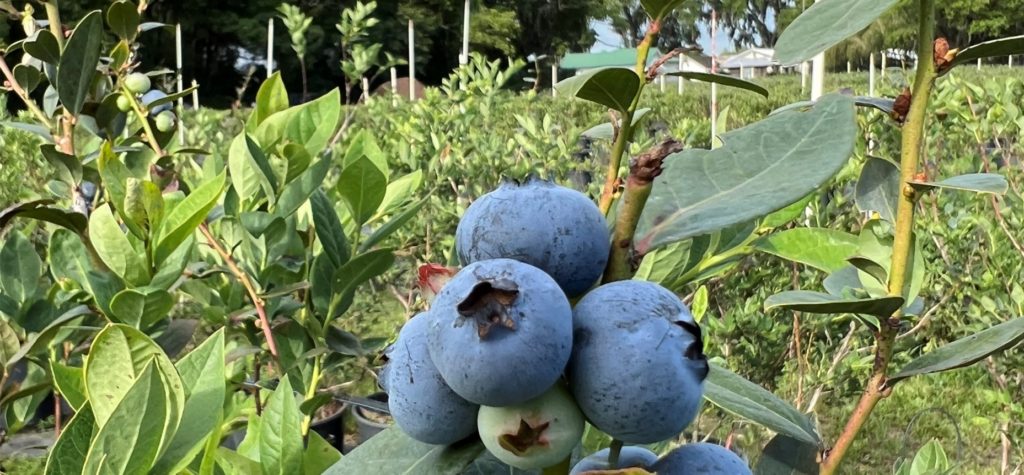Blueberry growing is a challenging business, and Wish Farms is good at it. Wish has been farming for 100 years and is one of the largest suppliers of high-quality berries in the US with operations in Florida, Georgia, North Carolina, California and Mexico.

When JC Clinard, Vice President of Operations, decided to install a two-acre demonstration field at their corporate headquarters, he decided on containerized berries and turned to the Spot-Spitter for irrigation. While the Spot-Spitter is an unconventional choice for blueberries, Mr. Clinard recognized it as a way to bring improvements to Wish’s growing operations. Having used it successfully in the demonstration field, he is now undertaking plans to bring Spot-Spitter irrigation to other larger fields owned by Wish and its sister company, Misty Organics.

What is the Spot-Spitter ?
Manufactured by Primerus Products, LLC, the Spot-Spitter is a small sprayer, or “spray stake”, designed to irrigate a single container. When pressurized, the Spitter creates a small and uniform spray pattern which covers an entire container without sending water outside of the container. Wetting of the entire container promotes uniform root development and healthier plant growth than can be easily achieved with other methods such as drip. In addition to these benefits, the Spitter is simple, low cost and extremely resistant to plugging. Its typical useful life is upwards of ten years.
Because of these benefits, the Spitter has been embraced by tree farms and ornamental nurseries for decades. In fact, it is the most commonly used irrigation device in US outdoor nurseries for 5 gallon and larger containers. Due to similarities between containerized berry cultivation and ornamental nurseries, progressive blueberry growers are taking notice.
Each Spot-Spitter is made from a single piece of UV-inhibited acetal plastic. Different Spitter models output from 3.0 to 15.0 gph and are color-coded by flow rate. The Standard Spot-Spitter is 5” long, however an oversized 12-inch “Tall” model (Spot-Spitter Tall) is also available and is popular with growers using artificial media due to the additional stability it offers. By itself, the Spitter is not a pressure-compensating device. In a well-designed system each Spitter delivers its nominal output by keeping supply pressure at 20 psi, or it can be used in conjunction with a compensating non-leak (CNL) emitter for pressure compensating operation.
Why grow blueberries in containers?

Growing blueberries in containers offers several benefits over field growing. First, individual containers with soil-less media allow total control of the root zone environment and the nutrients and chemicals the plant receives. pH management, in particular, is easier in a container than in the soil due to the smaller volume of material is being managed, and the fact many artificial media products have a lower starting pH than natural soil. Containers also provide a barrier to soil-borne pathogens, so disease pressure in one plant may be less likely to spread to adjacent plants if roots stay within a container barrier. Finally, containers can provide a faster path to organic certification than growing in a previously conventional field.
Blueberries are grown as a single bush per container in fairly large containers – typically 15-25 gallons. Most commonly, soil-less media is used. Wish Farms is using a combination of pine bark, peat moss and pearlite in the demonstration field. This is a conventional (non-organic) field, although only organic pesticides are used pre-harvest.
What are the irrigation alternatives for container blueberries?
Containerized blueberries need to be irrigated by an in-container device so water is not applied between containers. The most common method is drip irrigation using discrete online PC/CNL emitters which are connected to a polyethylene supply lateral and connected to each container by a length of 1/8-in tubing. Typically, the container-end of the 1/8” tubing is held in place in the container with a “drip stake”. This method allows accurate delivery of water and nutrients, but also has its challenges.
First, drip irrigation only applies water to a single point which is where the drip stake is inserted into the container. Water does not easily move laterally in artificial media so the output of the dripper goes straight to the bottom of the container without wetting the entire root zone. Farmers have addressed this issue by placing two, or more commonly four drip stakes in each container which is effective but can be complex and expensive. New “drip ring” products (Netafim NetBow or Primerus Pot-Dripper) address this issue by spreading the water from the emitter in a “ring” around the container.

Perhaps the biggest drawback of drip is its potential for clogging. The flow rates through a typical drip stake are low (1/2 gph or lower) and even lower through the outlets of a drip ring. Low flow rates mean small passageways that are easily clogged. Even worse, clogged emitters are not easily detected visually, and are often only noticed after damage has been done to the plants.

Advantages of the Spot-Spitter over Drip
The Spot-Spitter has several distinct advantages over Drip in container-grown blueberry applications:
- The Spot-Spitter provides superior root-zone coverage in comparison to either single or multiple drip points per container and is similar in coverage to drip rings.
- Only a single device is per container is required, so the Spot-Spitter is lower in cost than drip or drip ring irrigation.
- Due to its large flow channel and V-Groove mechanism, the Spot-Spitter is more tolerant to clogging than drippers and can be easily cleaned if clogging does occur.
- The Spot-Spitter spray can easily be seen, so problems are easy to detect. With drip irrigation, clogged emitters are often only detected when plants become stressed.
- The Spot-Spitter can be used to flush top-dressed fertilizers into the root zone. Drip irrigation can only be used with higher cost liquid fertilizers.
As you can see in the picture below, things can get pretty ugly in farming, but the Spot-Spitter keeps spraying!

How did Wish do it?
The Wish demonstration field is a two-acre showpiece for visitors to the corporate headquarters. The field is open to the public, and visitors are welcome to pick berries during the Spring harvest season.
The field was planted in early 2020 so is now two years old. Most of the plants have a full two years of development although one section has just completed its first year. The small field has 7,000 plants made up of four different varieties. Each plant is in a 20-gallon container with rows separated by lawn, providing a comfortable environment for visitors.

Wish decided on the Primerus Products Tall Orange (4.2 gph) Spot-Spitter. The larger Spitter gives good stability in the soil-less media, and also allows the spray head to be a few inches above the container surface for better coverage. Because the field is flat and the system is well controlled, the decision was made to go with non-pressure-compensating Spitters. 1-inch PE supply laterals are used to maintain good end-to-end uniformity, with a 20 psi Senninger fixed pressure regulator at the start of each row.

The Spitters are fed with well water that is cleaned with an Arcal automatic disk filter. Acid, sulphur and nutrients are injected at the pump station. A separate frost protection system is also in place which relies on Nelson Xcel Wobbler sprinklers and water pumped from a nearby pond.

How did it go?
Joe Baroodi, the Farm Manager who oversees the demonstration field, is extremely positive about the Spot-Spitters. “They are so much better than drip!” he says with enthusiasm. “It’s easy to see problems before they become serious – with a quick drive down the rows I can see any Spitters that aren’t flowing like they should be. And if you do see any clogging, they are easy to clean. With drip irrigated berries, sometimes you don’t see emitter clogging until the plants are stressed, and when you do find problems they are impossible to fix without replacing the drippers.”
The plants in the demonstration field are going strong after two years. This year’s harvest is nearly finished with just a few berries left. Perhaps the biggest challenge has been losses to birds – the Bird Guard system helps but is only about 70% effective at deterring the Cedar Waxwing. The thirty percent that are not deterred have enjoyed a lot of berries. There were also several plants lost to phytopthora– a situation that may have been worse had the berries been in-ground instead of in containers.
Challenges of irrigating with the Spot-Spitter
Perhaps the biggest challenge of using the Spot-Spitter on blueberries is in retrofit systems. Growers who hope to upgrade from drip to Spot-Spitters often quickly learn that their infrastructure is inadequate for the higher flow rates required by Spitters. While a drip system typically applies 1-2 gallons per hour per plant, a typical Spitter system requires 4+ gallons per hour. With Spitters, irrigation is done at a faster rate for shorter sets.
When retrofitting a drip system to Spitters, it is often necessary to upgrade the supply laterals at each row to a larger diameter. The higher flow rates will often also exceed what the PVC headers, or even the water supply can deliver. This can be addressed by organizing the field into a larger number of smaller zones, but doing so can require a nearly wholesale rework of the infrastructure. Better to design for Spitters from the start rather than retrofit.
The other challenges of the Spitter are more garden-variety issues that apply to any irrigation system. A qualified designer should lay the system out to ensure it is hydraulically sound and all containers get the same amount of water. Proper filtration should be used to avoid clogging, and care should always be taken when injecting fertilizer and chemicals.
How to Get Started
If you are considering a new container blueberry installation, or if you are hoping to retrofit an existing drip irrigated operation, learn more about the Spot-Spitter at GrowIrrigation.com. Once you have read our background information on the Spot-Spitter, call us at (442)279-3152 and we will walk you through the process given the specifics of your field.



